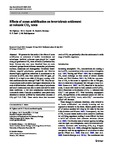Effects of ocean acidification on invertebrate settlement at volcanic CO2 vents
| dc.contributor.author | Cigliano, M | |
| dc.contributor.author | Gambi, MC | |
| dc.contributor.author | Rodolfo-Metalpa, R | |
| dc.contributor.author | Patti, FP | |
| dc.contributor.author | Hall-Spencer, JM | |
| dc.date.accessioned | 2013-02-20T09:10:03Z | |
| dc.date.available | 2013-02-20T09:10:03Z | |
| dc.date.issued | 2010-11 | |
| dc.identifier.issn | 0025-3162 | |
| dc.identifier.issn | 1432-1793 | |
| dc.identifier.uri | http://hdl.handle.net/10026.1/1333 | |
| dc.description.abstract |
We present the first study of the effects of ocean acidification on settlement of benthic invertebrates and microfauna. Artificial collectors were placed for 1 month along pH gradients at CO2 vents off Ischia (Tyrrhenian Sea, Italy). Seventy-nine taxa were identified from six main taxonomic groups (foraminiferans, nematodes, polychaetes, molluscs, crustaceans and chaetognaths). Calcareous foraminiferans, serpulid polychaetes, gastropods and bivalves showed highly significant reductions in recruitment to the collectors as pCO2 rose from normal (336-341 ppm, pH 8.09-8.15) to high levels (886-5,148 ppm) causing acidified conditions near the vents (pH 7.08-7.79). Only the syllid polychaete Syllis prolifera had higher abundances at the most acidified station, although a wide range of polychaetes and small crustaceans was able to settle and survive under these conditions. A few taxa (Amphiglena mediterranea, Leptochelia dubia, Caprella acanthifera) were particularly abundant at stations acidified by intermediate amounts of CO2 (pH 7. 41-7.99). These results show that increased levels of CO2 can profoundly affect the settlement of a wide range of benthic organisms. © 2010 Springer-Verlag. | |
| dc.format.extent | 2489-2502 | |
| dc.language | en | |
| dc.language.iso | en | |
| dc.publisher | Springer Science and Business Media LLC | |
| dc.subject | 31 Biological Sciences | |
| dc.subject | 3103 Ecology | |
| dc.subject | 14 Life Below Water | |
| dc.title | Effects of ocean acidification on invertebrate settlement at volcanic CO2 vents | |
| dc.type | journal-article | |
| dc.type | Article | |
| plymouth.author-url | https://www.webofscience.com/api/gateway?GWVersion=2&SrcApp=PARTNER_APP&SrcAuth=LinksAMR&KeyUT=WOS:000282828900014&DestLinkType=FullRecord&DestApp=ALL_WOS&UsrCustomerID=11bb513d99f797142bcfeffcc58ea008 | |
| plymouth.issue | 11 | |
| plymouth.volume | 157 | |
| plymouth.publication-status | Published | |
| plymouth.journal | Marine Biology | |
| dc.identifier.doi | 10.1007/s00227-010-1513-6 | |
| plymouth.organisational-group | /Plymouth | |
| plymouth.organisational-group | /Plymouth/Faculty of Science and Engineering | |
| plymouth.organisational-group | /Plymouth/Faculty of Science and Engineering/School of Biological and Marine Sciences | |
| plymouth.organisational-group | /Plymouth/PRIMaRE Publications | |
| plymouth.organisational-group | /Plymouth/REF 2021 Researchers by UoA | |
| plymouth.organisational-group | /Plymouth/REF 2021 Researchers by UoA/UoA07 Earth Systems and Environmental Sciences | |
| plymouth.organisational-group | /Plymouth/Research Groups | |
| plymouth.organisational-group | /Plymouth/Research Groups/Marine Institute | |
| plymouth.organisational-group | /Plymouth/Users by role | |
| plymouth.organisational-group | /Plymouth/Users by role/Academics | |
| dc.identifier.eissn | 1432-1793 | |
| dc.rights.embargoperiod | Not known | |
| rioxxterms.versionofrecord | 10.1007/s00227-010-1513-6 | |
| rioxxterms.licenseref.uri | http://www.rioxx.net/licenses/all-rights-reserved | |
| rioxxterms.type | Journal Article/Review |


